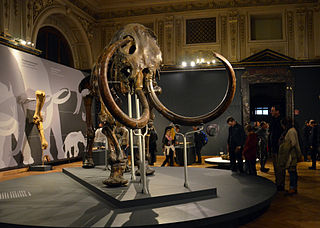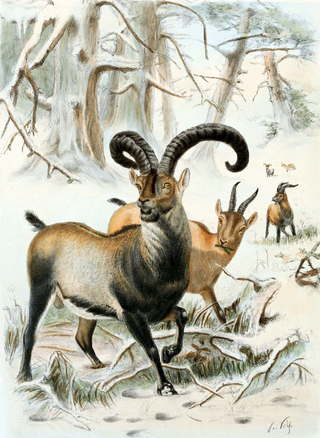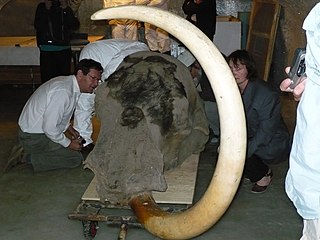Related Research Articles

A mammoth is any species of the extinct elephantid genus Mammuthus. They lived from the late Miocene epoch into the Holocene about 4,000 years ago, and various species existed in Africa, Europe, Asia, and North America. Mammoths are distinguished from living elephants by their spirally twisted tusks and in at least some later species, the development of numerous adaptions to living in cold environments, including a thick layer of fur.

The Laptev Sea is a marginal sea of the Arctic Ocean. It is located between the northern coast of Siberia, the Taimyr Peninsula, Severnaya Zemlya and the New Siberian Islands. Its northern boundary passes from the Arctic Cape to a point with co-ordinates of 79°N and 139°E, and ends at the Anisiy Cape. The Kara Sea lies to the west, the East Siberian Sea to the east.

The woolly rhinoceros is an extinct species of rhinoceros that inhabited northern Eurasia during the Pleistocene epoch. The woolly rhinoceros was a member of the Pleistocene megafauna. The woolly rhinoceros was covered with long, thick hair that allowed it to survive in the extremely cold, harsh mammoth steppe. It had a massive hump reaching from its shoulder and fed mainly on herbaceous plants that grew in the steppe. Mummified carcasses preserved in permafrost and many bone remains of woolly rhinoceroses have been found. Images of woolly rhinoceroses are found among cave paintings in Europe and Asia. The range of the woolly rhinoceros contracted towards Siberia beginning around 17,000 years ago, with the youngest known records being around 14,000 years old in northeast Siberia, coinciding with the Bølling–Allerød warming, which likely disrupted its habitat, with environmental DNA records possibly extending the range of the species around 9,800 years ago. Its closest living relative is the Sumatran rhinoceros.

The Taymyr Peninsula is a peninsula in the Far North of Russia, in the Siberian Federal District, that forms the northernmost part of the mainland of Eurasia. Administratively it is part of the Krasnoyarsk Krai Federal subject of Russia.

The Columbian mammoth is an extinct species of mammoth that inhabited North America from southern Canada to Costa Rica during the Pleistocene epoch. The Columbian mammoth descended from Eurasian steppe mammoths that colonised North America during the Early Pleistocene around 1.5–1.3 million years ago, and later experienced hybridisation with the woolly mammoth lineage. The Columbian mammoth was among the last mammoth species, and the pygmy mammoths evolved from them on the Channel Islands of California. The closest extant relative of the Columbian and other mammoths is the Asian elephant.

The mammoth steppe, also known as steppe-tundra, was once the Earth's most extensive biome. During glacial periods in the later Pleistocene it stretched east-to-west, from the Iberian Peninsula in the west of Europe, across Eurasia to North America, through Beringia and northwest Canada; from north-to-south, the steppe reached from the Arctic southward to southern Europe, Central Asia and northern China. The mammoth steppe was cold and dry, and relatively featureless, though climate, topography, and geography varied considerably throughout. Certain areas of the biome—such as coastal areas—had wetter and milder climates than others. Some areas featured rivers which, through erosion, naturally created gorges, gulleys, or small glens. The continual glacial recession and advancement over millennia contributed more to the formation of larger valleys and different geographical features. Overall, however, the steppe is known to be flat and expansive grassland. The vegetation was dominated by palatable, high-productivity grasses, herbs and willow shrubs.
The Sopkarga mammoth, alternately spelled Sopkarginsky mammoth, and informally called Zhenya, after the nickname of its discoverer, is a woolly mammoth carcass found in October 2012. It was discovered 3 kilometres (2 mi) away from the Sopkarga polar weather station on the Taymyr Peninsula in Russia. The Moscow News refers to it as the best preserved mammoth find in the past 100 years.

Lyuba is a female woolly mammoth calf who died c. 42,000 years ago at the age of 30 to 35 days. She was formerly the best preserved mammoth mummy in the world, surpassing Dima, a male mammoth calf mummy which had previously been the best known specimen.

The Adams mammoth is the first woolly mammoth skeleton with skin and flesh still attached to be recovered by scientists. The mostly complete skeleton and flesh were discovered in 1799 in northeastern Siberia by Ossip Shumachov, an Evenki hunter and subsequently recovered in 1806 when Russian botanist Mikhail Adams journeyed to the location and collected the remains.

The woolly mammoth is an extinct species of mammoth that lived from the Middle Pleistocene until its extinction in the Holocene epoch. It was one of the last in a line of mammoth species, beginning with the African Mammuthus subplanifrons in the early Pliocene. The woolly mammoth began to diverge from the steppe mammoth about 800,000 years ago in Siberia. Its closest extant relative is the Asian elephant. The Columbian mammoth lived alongside the woolly mammoth in North America, and DNA studies show that the two hybridised with each other.

The Mammoth Site is a museum and paleontological site near Hot Springs, South Dakota, in the Black Hills. It is an active paleontological excavation site at which research and excavations are continuing. The facility encloses a prehistoric sinkhole that formed and was slowly filled with sediments during the Pleistocene era. The sedimentary fill of the sinkhole contains the remains of Pleistocene fauna and flora preserved by entrapment and burial within a sinkhole. As of 2016, the remains of 61 mammoths, including 58 North American Columbian and 3 woolly mammoths had been recovered. Mammoth bones were found at the site in 1974, and a museum and building enclosing the site were established. The museum now contains an extensive collection of mammoth remains.
Dick "Sir Mammoth" Mol is a Dutch paleontologist - a specialist in the field of mammoths for almost three decades. He is a research associate of several museums. Mol's primary focus is on mammals of the Quaternary period, including mammoths and extinct rhinoceros species.

Yuka is the best-preserved woolly mammoth carcass ever found. It was discovered by local Siberian tusk hunters in August 2010. They turned it over to local scientists, who made an initial assessment of the carcass in 2012. It is displayed in Moscow.

De-extinction is the process of generating an organism that either resembles or is an extinct species. There are several ways to carry out the process of de-extinction. Cloning is the most widely proposed method, although genome editing and selective breeding have also been considered. Similar techniques have been applied to certain endangered species, in hopes to boost their genetic diversity. The only method of the three that would provide an animal with the same genetic identity is cloning. There are benefits and drawbacks to the process of de-extinction ranging from technological advancements to ethical issues.

The Yukagir Mammoth is a frozen adult male woolly mammoth specimen found in the autumn of 2002 in northern Yakutia, Arctic Siberia, Russia, and is considered to be an exceptional discovery. The nickname refers to the Siberian village near where it was found.

The Mammutmuseum Niederweningen is a paleontological and geological museum in the municipality of Niederweningen in the Wehntal valley, Canton of Zürich, Switzerland, and one of the few mammoth museums in Europe.

Genesis 2.0 is a documentary film made by Swiss director and producer Christian Frei and Russian filmmaker Maxim Abugaev. The feature-length film was released in January 2018 in the World Cinema Documentary section at the Sundance Film Festival. At the center of the film is the woolly mammoth, an extinct and iconic species that today is surrounded by wishes and visions. On the one hand, the film documents the hazardous daily lives of a group of men who gather valuable mammoth tusks in a remote archipelago, the New Siberian Islands. On the other, it illuminates the potential of genetic research and synthetic biology — the means by which researchers hope to bring the woolly mammoth back to life.
The Yana Rhinoceros Horn Site is an Upper Palaeolithic archaeological site located near the lower Yana river in northeastern Siberia, Russia, north of the Arctic Circle in the far west of Beringia. It was discovered in 2001, after thawing and erosion exposed animal bones and artifacts. The site features a well-preserved cultural layer due to the cold conditions, and includes hundreds of animal bones and ivory pieces and numerous artifacts, which are indicative of sustained settlement and a relatively high level of technological development. With an estimated age of around 32,000 calibrated years before present, the site provides the earliest archaeological evidence for human settlement in this region, or anywhere north of the Arctic Circle, where people survived extreme conditions and hunted a wide range of fauna before the onset of the Last Glacial Maximum. The Yana site is perhaps the earliest unambiguous evidence of mammoth hunting by humans.
References
- 1 2 3 Mol, D. et al. (2001). The Jarkov Mammoth: 20,000-Year-Old carcass of a Siberian woolly mammoth Mammuthus primigenius (Blumenbach, 1799). The World of Elephants, Proceedings of the 1st International Congress (October 16–20, 2001, Rome): 305-309. Full text pdf Archived 2011-07-22 at the Wayback Machine
- 1 2 "A Mammoth Excavation". WebCurrents. 2002. Archived from the original on 2 January 2010. Retrieved 11 January 2010.
- 1 2 3 4 DeLaine, Linda (15 March 2007). "Jarkov Mammoth". RussianLife.com. Archived from the original on 15 July 2011. Retrieved 11 January 2010.